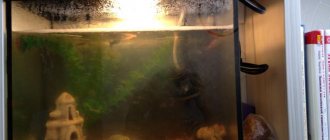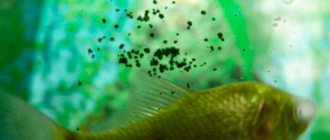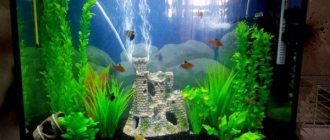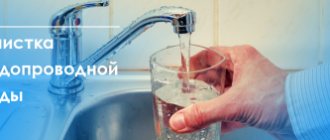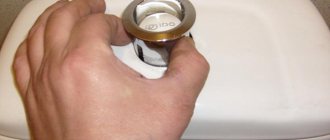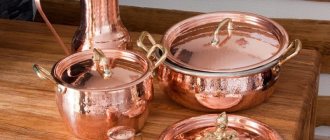An aquarium with fish is a great decoration for an apartment or office. In order for an artificial reservoir to please the eye, it is necessary to carefully care for it, keep it clean and tidy. Dirt and green deposits appear on glass walls, in the soil, and on the leaves of living and artificial plants. The filter gets clogged periodically. Garbage is formed from organic residues and fish waste. Proper and timely cleaning will help preserve the health of the inhabitants of the aquarium for a long time.
Let's look at how you can clean your home pond quickly and effectively.
How often should you clean your aquarium?
You need to clean the aquarium at least once a week. Depending on the size, population density, and amount of vegetation, more frequent cleaning may be necessary. The need for cleaning is best determined by the following external signs:
- Greenish coating on glass, plants, decorative items;
- Cloudy water;
- Cloudy “clouds” when the fish move.
All this suggests that the house of underwater inhabitants needs to be washed.
Attention! If the water in the vessel begins to change color, general cleaning is required immediately.
It would be a good idea to have a special aquarium test on your farm, which will determine the presence of substances harmful to the health of underwater inhabitants. Water should be checked for nitrates even if it is visually clean. For fish living in clean water, a value of 5-20 mg/l is suitable. For less demanding specimens, 20-30 mg/l is sufficient.
Reasons causing the problem
The brown coating in the aquarium is caused by diatoms - the oldest single-celled colonial microorganisms capable of processing all organic substances. In the natural environment, diatom plankton plays an important role, but in the limited space of an aquarium its presence is clearly negative.
Observe the temperature regime of the aquatic environment to protect the underwater kingdom from brown deposits
The reasons for their excessive activity may be the following factors:
- Incorrect lighting
- both a lack and an excess of light, the use of lamps not intended for the needs of aquariums, expired lamps, an incorrect combination of red and blue spectra can lead to an increase in biochemical processes and increased proliferation of diatoms. - Clogged or missing aquarium filter
- a device that purifies the water from food residues, applied fertilizers, organic waste from fish, that is, everything that can become an excellent breeding ground for brown diatoms. - Excess fertilizers, the presence of iodine or table salt
- almost all fertilizers contain nitrogenous compounds, the favorite delicacy of the “brown plague”, and if you pour them into the aquarium uncontrollably, beneficial algae simply will not have time to absorb their remains. This increases the risk of diatom infestation. - Irregular and poor cleaning of the aquarium
- home hygiene is very important for fish and algae. If you neglect cleaning, the accumulated deposits of organic matter will become a wonderful treat for unwanted parasitic guests. - A sudden change in the aquarium maintenance regime
, for example, when changing the owner, can put ordinary algae in a stressful state in which they cannot function normally. We can say with almost one hundred percent certainty that the insidious brown brothers will not miss such an opportunity and will take advantage of their opponent’s temporary weakness to recapture territory. - Failure to comply with the temperature regime
- the threshold water temperature in the aquarium should not fall below 18-20°C.
If no more than three months have passed since the manufacture of the aquarium, then the appearance of a brown coating in it is a natural physiological process. In such a short period of time, useful aquarium plants are only trying to adapt and do not yet have enough strength to resist the aggressor.
Rusty deposits spoil the entire appearance and can cause the death of higher plants
The chemical composition of the water at this moment does not yet have a stable nitrogen balance and has an alkaline environment favorable for diatom microorganisms: instead of ammonium absorbed by plants, ammonia consumed by algae predominates.
Once the aquarium plants are established and established, the brown algae will be defeated and the brown film will disappear - with proper care, of course.
Snails are a biological weapon against diatoms
Necessary equipment
To properly clean an aquarium, you will need special tools. They can be purchased at a pet store. It is better not to use improvised materials: small particles of the sponges we are used to can be deadly for fish.
To clean your aquarium you will need the following:
- The scraper is a dense sponge attached to the handle using a metal frame. It is convenient for cleaning glass from plaque.
- A siphon allows you to remove debris from the ground.
- A net for catching and transplanting fish into another container. Prepare a large jar of settled water for them.
- A toothbrush is useful for cleaning filter parts or small decorative elements.
- Paper or regular towels will help quickly dry up excess moisture.
- An aquarium pump is a device that allows you to quickly pump out a large volume of water from an artificial reservoir.
Advice! Instead of a siphon or pump, you can use a piece of ordinary hose of small diameter.
What detergents can I use?
The aquarium should be cleaned only with special products. Ordinary household chemicals are, for the most part, harmless to humans, but destructive to the underwater world. To avoid disaster, purchase an aquarium cleaner from a pet store. If unforeseen circumstances occur and you have to use a soap solution, rinse the vessel with running water several times. But it is better to avoid such situations and not abuse chemicals.
Beginning aquarists are wondering whether it is permissible to clean the vessel with improvised means - salt or soda?
Some people use traditional methods quite successfully.
- Transfer the fish using a net into another vessel with settled water. Cover the container with a towel to prevent the fish from jumping out, frightened by the excessively bright light.
- Pour out the dirty liquid and rinse the walls with hot water, sprinkle the glass generously with soda and leave for 15 minutes. Sea salt works in a similar way.
- Rinse the fish house thoroughly under the tap to remove all the alkali.
- Rinse the aquarium with settled water prepared for filling.
- While the walls of the tank are wet, blot them with a paper towel and polish them.
How to properly clean an aquarium?
To start cleaning, remove the fish from the aquarium into a separate container and get to work.
Wash the walls
A greenish coating forms on the walls due to algae. They inevitably appear even in the cleanest vessel. To clean glass and get rid of green deposits, take a scraper and carefully remove dirt. There is no need to pour out the water. If your household does not yet have the necessary tool, you can use a stationery knife or a plastic card that has expired. But be careful - foreign objects can leave scratches.
For deep containers with hard-to-reach corners, it is better to purchase a magnetic scraper. It does not scratch the walls and allows you to clean surfaces without putting your hands in the water. The plaque is cleaned off easily and quickly.
Limescale deposits on aquarium glass are caused by water that is too hard and contains a lot of minerals. You can clean it in several ways, including traditional ones:
- Special cleaning compounds. The chemical should be applied to the walls of the empty aquarium according to the instructions. Don't forget to rinse thoroughly.
- Lemon acid. Dissolve 20 g of the substance in a glass of water and apply to glass.
- Hydrogen peroxide. Dilute in a ratio of 1 tbsp. l. per 100 ml of water.
- Alcohol. Dilute with water in a ratio of 1:10, mix well.
To make it more convenient to apply the composition to glass, you can use a spray bottle or thin gauze. Remember that any product must be washed off very carefully: underwater organisms are sensitive to foreign substances.
Cleaning the bottom
Cleaning an aquarium includes cleaning the bottom. Remains of food, excrement of the inhabitants of the aquarium and other debris settle on it.
First of all, you need to carefully remove the stones and all the decor. Remember that it is highly undesirable to use household detergents. Rinse the jewelry under running water and wipe it with a sponge. If things are very dirty, soak them in a special solution for 15 minutes.
A siphon is used to clean the soil. The devices come in different types, but have almost the same principle of operation.
Run the siphon tube over the ground, starting with the most contaminated areas. Pour the pumped out water into a bucket. Check to see if any small fish have gotten into it.
Advice! If the fish in the aquarium is large enough, you can put the end of the hose directly into the sink - this will make the process easier.
The siphon is not used if there are shrimp or other small animals in the aquarium - they can be easily injured. Also, the siphon cannot be used on soils in herbal gardens - it can damage the roots of plants.
If this item is not available on the farm, you can take out the soil, put it in a bucket and rinse it under running water. Clean stones and shells overgrown with silt and algae with a toothbrush.
Attention! This method is not suitable for nutrient soil that contains plant food.
Green areas also require special care. Spoiled and damaged leaves need to be cut off, as well as overgrown ones. There is no point in creating “jungles” - they will interfere with the fish’s ability to move freely.
Cleaning the filter
It is recommended to clean the aquarium filter once a month. But you should not wash it too thoroughly - you can destroy beneficial bacteria, thereby disturbing the biological balance in the aquarium. Disassemble the filter and carefully clean it with a toothbrush, rinse out any dirt that has settled in the crevices. Rinse the elements in aquarium water - this way the microflora is preserved.
Attention! If the filter contains carbon, ammonia absorbers or ion exchange resins, it must be replaced monthly.
The device that acts as a mechanical filter (ie ceramic rings, filter fibers or sponge) should be carefully washed to remove debris and replaced.
After general cleaning, you need to wait a little before cleaning the filter: a certain amount of beneficial bacteria remains in it, which will help maintain biobalance in the renewed reservoir.
Filling with water
You should not replace all the water with each cleaning - this will upset the ecological balance, and it will be difficult for the inhabitants of the aquarium to adapt. General cleaning is carried out only in cases of extreme necessity - for example, during epidemics. New water should be allowed to sit for several days so that chlorine and other harmful substances evaporate from it, and only then poured into the aquarium.
You can replace a little water at a time, or half of it - it depends on the degree of pollution, population density, filter power and other factors. The presence of living plants plays an important role - they often act as natural filters.
With regular maintenance, about 25% of the water is replaced. This is the best option for maintaining cleanliness.
How to get rid of greens in an aquarium
If after cleaning the walls and bottom are again covered with greenery, you will have to resort to additional measures. How to remove green plaque in this case:
- First of all, you need to check the balance of the biological environment: check the water temperature, the regularity and intensity of lighting, and the health of the inhabitants. Sick fish produce harmful waste that forms a coating on the glass of the aquarium. You may need special water purification and disinfection products, which you can find in a pet store. It is necessary to maintain a balance between vegetation and fish. If the tank is small, do not stock it with many fish. 1-15 fish, even the smallest ones, cannot live in a 20-30 liter tank. The abundance of fish and plants leads to greening of the water and reservoir.
- Place the aquarium away from direct sunlight. The distance between the window and the fish tank should not be less than 1.5 meters. Direct sunlight causes strong blooming of water and the acidity level is disturbed.
- If the appearance of green plaque on the walls of the aquarium is caused by microorganisms or bacteria, you will have to fight it with antibiotics. You can buy them at a pet store. Riboflavin, Rivanol, Tripaflavin are used to remove greens. Before using an antibiotic, follow the instructions for use. Remember that antibiotics can harm some inhabitants, such as snails. There is no need to change the water when using antibiotics.
How to clean an aquarium without draining the water?
If little time has passed since the last cleaning and there are few mud deposits, you do not need to pour out the water. It is necessary to remove and wash filters, internal lighting and aeration systems, and decorative elements. Then use the already familiar method - a special scraper - to clean the dirty areas.
A siphon will help you clean the bottom of the aquarium without draining the water. You can use it to remove dirt and then add a small amount of water that was drained during cleaning.
This method is quite fast, but it may be difficult to clean corners and hard-to-reach places.
To maintain the water level, use a net to clean the soil. Immerse the tool in the sand and carefully sift it: the debris will remain in the net, and small grains of sand will settle to the bottom again. In this way, you can wash the aquarium directly with the fish, without wasting time on catching.
Advice! If the water has been drained, pour new water carefully, avoiding erosion of the soil.
Tips for care and use
In order for an aquarium with underwater inhabitants to bring exclusively positive emotions to the owner, simple rules should be followed:
- Use only soft, purified water. It will contain few salts, and, as a result, less hardness. This will reduce the amount of limescale deposits. However, water completely devoid of minerals should not be used: fish need the substances in small quantities.
- Buy special supplements at the pet store. They will help reduce calcium content and reduce water hardness. You can periodically dilute distilled water.
- Maintain the filter regularly - it is its condition that guarantees the cleanliness of the aquarium and the health of the fish.
- If the fish shows signs of illness (lethargy, change in behavior, etc.), urgently transfer it to a separate container - this will help avoid an epidemic.
In order for the water to remain clean and clear, the aquarium must be in biological balance. For example, beneficial bacteria break down excrement and food debris. The waste becomes suitable for feeding plants, which, in turn, are able to purify water and release the oxygen necessary for living creatures.
A great way to make cleaning easier and diversify the aquarium population is to have natural “helpers”.
- Shellfish actively fight algae by eating them. In addition, snails clean plaque from the walls.
- Shrimp eat dead parts of plants and absorb algae.
- Some fish feast on algae. They can also be placed in a pond.
An aquarium is a rather complex ecosystem with its own orders. Your task is to maintain the necessary balance. Be careful when settling the aquarium, handle it carefully, and then your home pond will bring you joy.
Causes of white plaque and methods of control
The appearance of white (flakes) plaque on the walls of the tank and algae leaves does not cause much harm. This is primarily due to improper care of the reservoir.
This plaque consists of colonies of saprophytic bacteria. When magnified, their accumulations look like white or beige lumps of mucus and individual elongated strands.
Microorganisms feed on organic debris - rotting food, waste products of fish, dead parts of plants. If the aquarium is not properly cared for, rarely cleaned and the water is changed, organic compounds accumulate in abundance on the soil and provoke an outbreak of bacterial growth.
Whitish accumulations can be found in different places:
- On the glass surface;
- on the ground;
- on stones, snags and artificial decorations of the reservoir;
- on the leaves and stems of higher algae.
This bacterial plaque is to some extent even beneficial for the health of the inhabitants of the aquarium. When organic pollution occurs, nitrites and ammonia accumulate in water, which are dangerous for fish and plants. Single-celled organisms actively break down toxic products. Safe nitrates are formed, which are easily absorbed by plants.
If it were not for the colonies of saprophytes, most aquarium fish would soon die. Therefore, you should not immediately resort to chemical antibacterial drugs. You should start improving your health with more careful aquarium care, filtration and regular water changes. The amount of food for fish should be such that they have time to eat everything at once.
Procedure for removing white plaque:
- All plants are carefully inspected. Decaying and dead parts, dirt from the soil, and food debris are removed.
- The filter sponges are washed with running water. The use of cleaning chemicals is not recommended.
- The filter fillers are washed with water at room temperature.
- Regularly replace water by 1/5-1/6 of the total volume. The water temperature should be from +18…+22°С.
- If there are too many fish and algae growing in one reservoir, the excess should be deposited in another reservoir.
- You cannot introduce new fish or plants or change food at this time.
Gradually, the biological balance in the aquarium will be restored and the white coating will disappear.
Other interesting articles
- Why do plants in an aquarium die? Why do plants in an aquarium rot and get sick, and how to avoid it Since you are reading this...
- What fish can live without aeration, air in the aquarium? What fish can survive without oxygen and filtration? No living creature can live without...
- Does loud music affect fish in an aquarium? Aquarium fish are rightfully considered one of the most delicate and vulnerable pets. Their calm...
